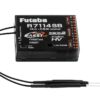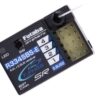Small and very light four-channel telemetry receiver Futaba T-FHSS Air-2.4GHz with S.BUS and S.BUS2 ports for telemetry sensors and other devices. Power supply 4.8-7.4 V, dimensions 18.0×41.4×9.9 mm,
Small four-channel telemetry receiver Futaba of the T-FHSS Air-2.4GHz transmission system with a pair of full-range diversity antennas. It is intended for use in models of all categories; Thanks to its compact dimensions, low weight and connectors inserted in the longitudinal axis, it is also suitable for small models. The R3004SB provides 4 standard PWM channel outputs and an S.BUS2 port for bidirectional communication allowing the connection of S.BUS2 servos and telemetry sensors. The operating states of the receiver are indicated by an LED indicator.
Transmission system
Futaba T-FHSS Air-2.4GHz for flying models. It is not compatible with the T-FHSS Surface 2.4GHz transmission system used by Futaba RC kits for RC cars, other ground equipment and boats.
Power supply
4.8-7.4 V (nominal voltage) – ie eg 4-6 cells NiMH, 2S LiPo, LiFe, Li-ion batteries, BEC power stabilizers in the given voltage range.
Antenna
The receiver is equipped with a pair of diversity antennas in order to maximize signal reception regardless of the relative position of the model and the transmitter. These must be fastened in the model with a mutual orientation of 90 °.
Receiver outputs
The receiver allows to connect standard Futaba connectors (with protrusion) as well as UNI connectors (= JR / Graupner, Hitec) without a side protrusion.
Channel outputs (PWM): The R3004SB offers 4 classic PWM channel outputs that can be used simultaneously with the S.BUS2 serial bus.
S.BUS2: The S.BUS2 socket allows the connection of S.BUS2 servos, gyroscopes and other compatible devices and the connection of Futaba telemetry sensors, the data of which can be displayed on the transmitter.
Telemetry
The RR3004SB transmits data on the receiver’s supply voltage to the transmitter without the need to connect any sensors.
The R3004SB allows the use of all Futaba telemetry sensors and other sensors compatible with the SB bus system US2 with two-way communication.
The receiver set includes: R3004SB receiver, operating instructions.
What Is S.BUS2 / S.BUS
- S.BUS – Futaba serial bus with one-way communication enabling control of servos, controllers, switches, gyroscopes and other compatible RC devices connected to a single output port of the S.BUS receiver.
- S.BUS2 – Futaba serial bus for bidirectional communication enabling (as S.BUS) control of servos, controllers, switches, gyroscopes and other compatible RC devices connected to a single output / input port of the S.BUS2 receiver. In addition, it allows the connection of telemetry sensors and the transmission of data from them via a receiver for display on the transmitter; from some S.BUS2 servos can transmit information about the operating current, temperature or angle of the servo output lever to the transmitter.
Unlike conventional RC S.BUS (2) kits, the system uses serial data communication to transmit control signals from the receiver to a servo, gyro or other device. This data contains commands such as “move servo channel 3 to 15 degrees, move servo channel 5 to 30 degrees” for multiple devices. S.BUS (2) devices only execute commands corresponding to their own set channel. For this reason, it is possible to connect several servos to the same signal cable, while setting and controlling them individually as needed. The servo identification code (ID) is used for this. You can find the ID on the sticker on the servo box.
The S.BUS2 servo can be connected to both S.BUS2 and S.BUS ports of the receiver. Its function is given by setting the channel in the servo memory (it is performed using the programming interface of the Futaba transmitter, SBC-1 programmer or CIU-3 USB interface with PC program S-Link – for some servos the channel can be set only with the transmitter).
The S.BUS or S.BUS2 servo connected to the channel output of the classic receiver (PWM) works like a classic servo. Its movement is given by a signal in the channel of the receiver to which it is connected. The settings of the programmable servo functions remain valid.












Reviews
There are no reviews yet.